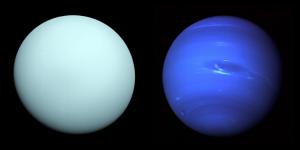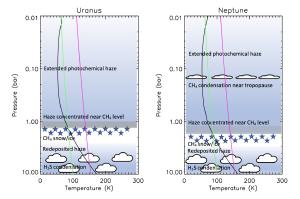Blog
The Bluest Sky
8 February 2022
 Left: NASA/JPL-Caltech, Right: NASA
Left: NASA/JPL-Caltech, Right: NASAUranus and Neptune are similar planets in many ways. Both are ice giant worlds, both have atmospheres rich in methane, and both have a bluish color. But while Uranus has a pale blue-green hue, Neptune has a deep blue color. But why? Why would two planets so similar in size and composition appear so different? According to a recent study, the answer lies in their aerosols.1
Aerosols are small dust particles or droplets of liquid that are suspended within a gas. On Earth, we often think of aerosols as a form of pollution, since smoke and smog are aerosols. But aerosols can also be less harmful things such as the mist of a fog, or a cloud of tiny ice crystals on a cold winter’s night. If you have an atmosphere, you are bound to have aerosols.
Aerosol particles can be so small that their diameters are roughly the same as the wavelengths of visible light. Because of this, the way light scatters off them can depend on the light’s wavelength. Through a process known as Mie scattering, long red wavelengths usually scatter more than shorter blue wavelengths. Mie scattering is why Mars often has a tan sky rather than a blue one, and why sunsets on Mars are often blue. As this latest study shows, aerosols play a significant role in the coloring of Uranus and Neptune, but the connection is not a simple one.
The atmospheres of Uranus and Neptune are mostly hydrogen and helium, but they are also rich in methane (CH4). Methane absorbs red light and reflects blue, which is why both planets have a generally blue color. There are traces of other elements in their atmospheres, and the chemical reactions between various molecules can create a haze of aerosols that can taint their basic blue hue.
 Irwin, et al
Irwin, et alBased on spectral observations of Uranus and Neptune, the team devised a model where there are three main types of aerosols, numbered by how deep they are located within the planet’s atmosphere. The deepest layer is Aerosol-1, which seems to be a combination of molecular smog and ice particles of hydrogen sulfide (H2S). Hydrogen sulfide reflects green light while absorbing red and blue, which helps give Uranus its greenish tinge. The middle layer of aerosol-2 doesn’t reflect much visible light but does reflect ultraviolet and infrared. The highest layer is aerosol-3. It is composed of particles smaller than a micron and tends to reflect visible light about the same at all colors. The aerosol-3 layer is thicker on Uranus, making it appear paler than Neptune. Neptune also has an upper layer of methane ice clouds, helping it maintain its deep blue.
This layering of aerosols could also help explain storms on the two planets, such as the great blue spot seen on Neptune as it was visited by Voyager II. As the upper layers are cleared by a storm, the deeper, bluer layer is more easily seen.
While this unified model of aerosol layers can explain the appearance of both worlds, alternatives can’t be ruled out. The team also came up with different models that would explain Uranus and Neptune separately. But the unified model works well and could help us explain the atmospheres of icy gas worlds around other stars.
Irwin, Patrick GJ, et al. “Hazy blue worlds: A holistic aerosol model for Uranus and Neptune, including Dark Spots.” arXiv preprint arXiv:2201.04516 (2022). ↩︎